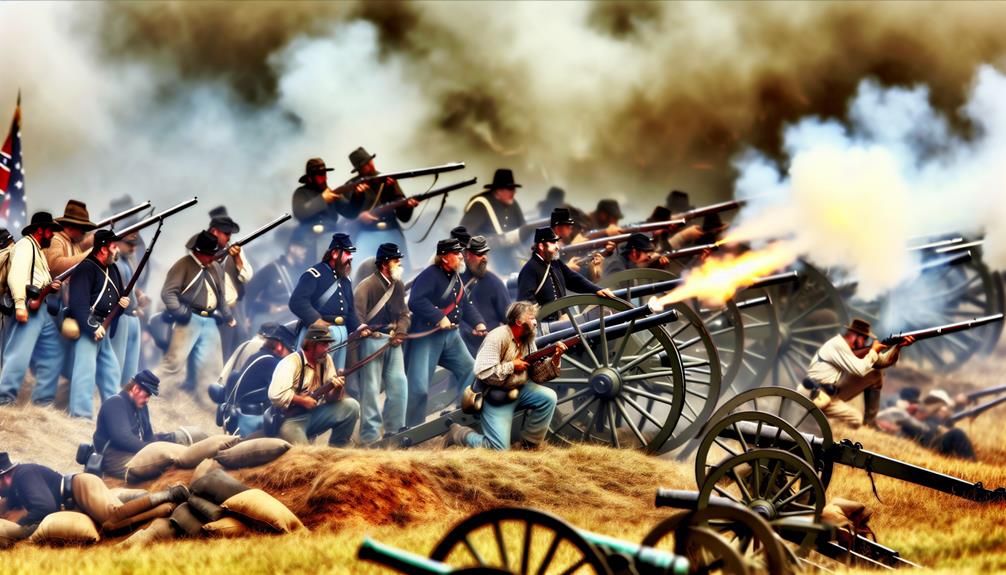The Battle of Gettysburg stands as a defining moment in the chronicles of the American Civil War, where the clash between Union and Confederate forces reverberated through the annals of history. General Robert E. Lee's strategic gamble and the subsequent Union victory on those hallowed grounds shifted the course of the war. However, beyond the tactical maneuvers and casualties lies a deeper narrative that encapsulates the essence of the conflict and its enduring impact on American society. The repercussions of Gettysburg extend far beyond the battlefield, shaping the nation's trajectory in unforeseen ways that continue to resonate today.
Key Takeaways
- Gettysburg halted Confederate invasion, shifting momentum.
- Union victory boosted morale and hope for preservation.
- Lincoln's Address emphasized democracy, equality, and liberty.
- Battle symbolized sacrifice and honored fallen soldiers.
- Ensured lasting legacy of American identity and resilience.
Prelude to Gettysburg
In the lead-up to the pivotal Battle of Gettysburg, a series of strategic maneuvers and clashes between Union and Confederate forces set the stage for one of the most critical confrontations of the American Civil War. The causes leading to this monumental clash were rooted in the Confederate Army of Northern Virginia's bold offensive strategy under General Robert E. Lee, aiming to take the war to Union territory and relieve pressure on war-torn Virginia. Lee's decision to invade the North was also motivated by the hope of securing foreign recognition and support for the Confederacy.
Consequently, the consequences of these strategic decisions were far-reaching. The Confederate invasion of Maryland and Pennsylvania not only brought the war directly to Northern soil but also heightened the stakes of the conflict. The Union Army, under the command of General George Meade, was forced to confront Lee's forces in a battle that would have profound implications for the outcome of the war.
The clashes leading up to Gettysburg, such as the engagements at Brandy Station and Winchester, served as precursors to the main event. These skirmishes provided crucial intelligence to both sides, shaping their strategies for the impending showdown at Gettysburg. Overall, the prelude to Gettysburg was a complex interplay of military tactics, strategic decisions, and shifting fortunes that would culminate in a defining moment of the American Civil War.
Confederate Invasion of the North
The Confederate invasion of the North marked a pivotal shift in the course of the American Civil War, as General Robert E. Lee's Army of Northern Virginia undertook a daring campaign to bring the conflict directly to Union territory. This bold move by the Confederates set the stage for a series of events that would culminate in the Battle of Gettysburg, a turning point in the war.
- Strategic Goals: The Southern strategy aimed to alleviate pressure on war-torn Virginia, disrupt Union supply lines, and potentially influence European powers to recognize the Confederacy.
- Northern Vulnerabilities: The invasion exposed weaknesses in the Union's defensive positions, revealing gaps in intelligence and communication that the Confederates sought to exploit.
- Civilian Impact: The Confederate presence instilled fear among Northern civilians, leading to widespread panic and calls for protection from the Union government.
- Military Maneuvers: Lee's army moved swiftly and decisively, outmaneuvering Union forces in a series of engagements that showcased the Confederacy's military prowess.
The Northern response to this invasion was mixed, with some advocating for a cautious approach to avoid a direct confrontation, while others pushed for aggressive action to repel the Confederate forces. As both sides scrambled to position themselves for the impending clash, the stage was set for the epic confrontation that would unfold at Gettysburg.
Union Defensive Strategy
Union defensive strategy during the Confederate invasion of the North was characterized by a meticulous assessment of the threats posed by General Robert E. Lee's advancing Army of Northern Virginia. The Union forces, under the command of General George G. Meade, implemented a series of defensive maneuvers and strategic positioning to counter Lee's aggressive movements. Meade recognized the importance of choosing the right ground for the impending confrontation, aiming to leverage the natural landscape to his advantage.
One key aspect of the Union defensive strategy was the selection of strong defensive positions, such as Cemetery Hill and Culp's Hill, near Gettysburg, Pennsylvania. These elevated positions provided excellent vantage points and made it challenging for the Confederate forces to launch effective attacks. Meade's decision to position his troops on advantageous terrain played a significant role in the outcome of the battle.
Furthermore, the Union forces skillfully utilized their knowledge of the local geography to establish a defensive line that stretched over several miles, effectively blocking Lee's advance and forcing him to engage in direct combat. By strategically deploying their troops along key points of the battlefield, the Union army was able to create a formidable defensive front that proved difficult for the Confederates to breach.
Opening Clashes at Gettysburg
Amidst the rolling fields and scattered woodlands surrounding Gettysburg, the opening clashes of the pivotal American Civil War battle unfolded with intensity and strategic maneuvering. As the two great armies, the Union Army of the Potomac and the Confederate Army of Northern Virginia, converged on this small Pennsylvania town, the stage was set for a momentous confrontation that would shape the course of the war.
- Early Skirmishes: The initial engagements at Gettysburg began with scattered skirmishes between Confederate and Union cavalry units probing each other's positions, testing defenses, and gathering critical intelligence about the enemy's strength and disposition.
- Strategic Maneuvers: Both General Robert E. Lee of the Confederacy and General George G. Meade of the Union recognized the strategic importance of the high ground around Gettysburg. Maneuvering their troops deftly, they sought to gain an advantage in positioning and control key areas.
- Tactical Deployments: Troops were swiftly positioned along ridges, in valleys, and behind stone walls, preparing for the fierce fighting that lay ahead.
- Artillery Exchanges: The thunderous roar of cannons marked the beginning of the artillery duels as both sides sought to soften the enemy's defenses and weaken their resolve.
In these early clashes at Gettysburg, the seeds of the decisive battle were sown, setting the stage for the intense fighting that would follow in the days ahead.
The Tide Turns: Pickett's Charge
As the Confederate forces under General Robert E. Lee prepared for a decisive assault, a critical moment loomed at Gettysburg known as Pickett's Charge. On July 3, 1863, Lee ordered approximately 12,500 Confederate soldiers, led by General George Pickett, to advance across open fields towards the center of the Union line on Cemetery Ridge. The Confederate soldiers faced a challenging task as they had to traverse nearly a mile of open ground under heavy artillery and rifle fire.
Despite their courage and determination, the Confederate troops suffered devastating losses during Pickett's Charge. The Union forces, well-entrenched and supported by artillery, inflicted high casualties on the advancing Confederates. The failed assault resulted in a significant turning point in the Battle of Gettysburg, marking the beginning of the end for the Confederate army in the pivotal battle.
The aftermath of Pickett's Charge left the Confederate forces in a weakened state, both physically and mentally. The high casualties sustained during the failed assault dealt a severe blow to Confederate morale and highlighted the challenges faced by Lee's army in overcoming the Union defenses at Gettysburg. The failed charge ultimately contributed to the Union victory at Gettysburg and played a vital role in turning the tide of the American Civil War in favor of the Union forces.
Devastating Losses and Retreat
Following the devastating losses incurred during Pickett's Charge, the Confederate forces faced the grim reality of retreat as they grappled with the aftermath of the failed assault at Gettysburg. The retreat of the Confederate army marked a significant turning point in the battle, leading to profound consequences for both sides involved.
- Union casualties: The Union forces also suffered heavy casualties during the intense fighting at Gettysburg. The losses on both sides were a stark reminder of the critical nature of war and the sacrifices made by soldiers on the battlefield.
- Confederate retreat: The retreat of the Confederate forces was a strategic necessity as their failed assault left them vulnerable to further Union attacks. The withdrawal was a challenging decision, but vital to regroup and avoid further decimation.
- Supply shortages: The Confederate retreat was hampered by severe shortages of essential supplies such as food, ammunition, and medical provisions. These shortages added to the challenges faced by the retreating troops.
- Commander disarray: The Confederate leadership faced disarray and confusion as they attempted to orchestrate an organized retreat. Communication breakdowns and conflicting orders exacerbated the chaos of the situation.
The devastating losses and subsequent retreat at Gettysburg highlighted the brutal realities of war and set the stage for the aftermath and impact that would reverberate throughout the American Civil War.
Aftermath and Impact
In the aftermath of the Confederate retreat from Gettysburg, the implications of the battle began to unfold, shaping the course of the American Civil War with far-reaching consequences for both the Union and Confederate forces. The Battle of Gettysburg, fought from July 1 to July 3, 1863, resulted in over 50,000 casualties, marking a significant turning point in the war. The Confederate Army, under General Robert E. Lee, suffered a devastating defeat, leading to their withdrawal from Union territory and effectively ending their invasion of the North.
The aftermath of Gettysburg saw the Union forces emboldened by their victory, boosting morale and belief in their cause. On the other hand, the Confederate forces were demoralized and weakened, facing challenges in terms of resources and manpower. The battle's impact was not limited to military outcomes but extended to political and social spheres, setting the stage for Reconstruction efforts post-war.
The lasting significance of Gettysburg lay in its role as a catalyst for the eventual Union victory in the Civil War. The battle highlighted the strategic prowess of Union generals, particularly George G. Meade, and dealt a severe blow to the Confederate army. Additionally, Gettysburg underscored the importance of decisive battles in determining the course of the war, influencing future military strategies on both sides. The memory of Gettysburg, with its staggering casualties and historical importance, continues to resonate in American history as a symbol of sacrifice and national unity.
Gettysburg Address
The aftermath of the pivotal Battle of Gettysburg paved the way for President Abraham Lincoln to deliver the historic Gettysburg Address, a speech that would resonate deeply in American history. Lincoln's speech, delivered on November 19, 1863, at the dedication of the Soldiers' National Cemetery in Gettysburg, Pennsylvania, encapsulated the significance of the Civil War and reinforced the principles of human equality and democracy.
- Short and Symbolic: Despite its brevity, Lincoln's speech profoundly captured the essence of the nation's struggle and sacrifice during the Civil War.
- Unity and Healing: The Gettysburg Address emphasized the importance of national unity and healing the wounds of a divided country, setting the stage for reconstruction.
- Democracy and Equality: Lincoln's words highlighted the enduring values of democracy, equality, and liberty, inspiring generations of Americans to uphold these principles.
- Legacy and Impact: The Gettysburg Address left a lasting legacy, shaping the nation's collective memory of the Civil War and serving as a touchstone for future leaders and movements.
Lincoln's speech at Gettysburg transcended its immediate context, becoming a timeless symbol of American identity and resilience. Its reverberations through history underscored the profound Civil War implications, emphasizing the enduring struggle for freedom and unity in the face of adversity.
Legacy of Gettysburg
The enduring legacy of the Battle of Gettysburg has profoundly shaped the historical narrative of the American Civil War. Gettysburg's significance lies not only in its geographical location but also in the pivotal role it played in determining the outcome of the war. This battle marked a turning point in the conflict, as it halted General Robert E. Lee's ambitious invasion of the North and dealt a significant blow to the Confederate army. The Union victory at Gettysburg boosted Northern morale and renewed hope for ultimate success in preserving the Union.
Moreover, the historical importance of Gettysburg extends beyond the military domain. The battle sparked President Abraham Lincoln's famous Gettysburg Address, a speech that redefined the war as a struggle for equality and liberty. Lincoln's words emphasized the nation's founding principles of freedom and democracy, resonating with generations to come. The Gettysburg Address encapsulated the sacrifice of those who fought and died on the battlefield, ensuring that their memory would forever be honored.
Frequently Asked Questions
How Did the Local Civilian Population at Gettysburg Cope During the Battle?
During the battle at Gettysburg, the local civilian population displayed remarkable civil resilience in the face of immense turmoil. Despite the chaos and destruction surrounding them, the community came together to provide support and assistance to one another.
This collective effort helped the civilians cope with the challenges of war, demonstrating the strength and unity that can emerge during times of crisis.
Were There Any Significant Medical Advancements Made During the Battle?
During the Battle of Gettysburg, significant medical advancements emerged, shaping modern battlefield triage. Innovations such as rapid treatment and transport of wounded soldiers, improved surgical techniques, and organized medical corps were pioneered.
This revolutionized the approach to caring for the injured during conflicts, leading to enhanced survival rates and better outcomes for soldiers. The developments at Gettysburg laid the groundwork for modern military medical practices and continue to influence healthcare systems today.
What Role Did African American Soldiers Play in the Battle of Gettysburg?
African American soldiers played a significant role in the Battle of Gettysburg, showcasing their bravery and dedication amidst the wartime struggles.
Their contributions had a profound impact on the outcome of the battle, highlighting the importance of racial integration within the military.
Despite facing discrimination and unequal treatment, these soldiers fought valiantly, proving their worth on the battlefield and paving the way for greater recognition of African American service in the Civil War.
How Did the Battle Impact the Environment and Wildlife in the Area?
In evaluating the environmental impact of the Battle of Gettysburg, it becomes apparent that the extensive conflict had profound repercussions on the local ecosystem and wildlife preservation efforts.
The sheer scale of the battle, with its destruction of natural habitats and contamination of water sources, resulted in long-lasting consequences for the environment in the area.
Understanding and mitigating these effects are essential for promoting sustainable practices and preserving the delicate balance of nature.
Were There Any Notable Artistic or Literary Works Inspired by Gettysburg?
Artistic interpretations and literary tributes inspired by Gettysburg showcase the battle's enduring impact on culture. Renowned painters like Paul Philippoteaux captured the battlefield's intensity in monumental works. Poets like Walt Whitman and Herman Melville penned moving verses that immortalized the battle's significance.
These artistic and literary creations not only commemorate the events at Gettysburg but also offer profound insights into the human experience amidst conflict and sacrifice.
Conclusion
To sum up, the Battle of Gettysburg marked a pivotal turning point in the American Civil War, with General Robert E. Lee's Confederate forces suffering a significant defeat.
One interesting statistic to note is that over 51,000 soldiers were killed, wounded, or missing during the three-day battle, highlighting the devastating impact of the conflict.
This historic event not only halted Lee's invasion of the North but also inspired President Abraham Lincoln's Gettysburg Address, emphasizing the values of equality and liberty.


